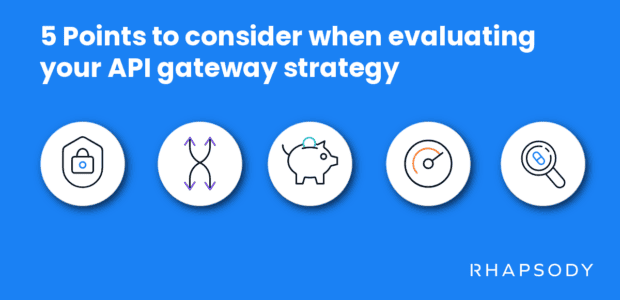Using APIs in Healthcare
Easier access to health data with APIs
Application programming interfaces (APIs) make it easy for healthcare applications to connect and exchange data in a repeatable way — regardless of how the applications were designed — empowering healthcare organizations to realize the value of data and access information faster than ever.
Connect with an API expert
White paper
Breaking down interoperability barriers is possible through APIs
An introduction to APIs and how they can help solve health IT’s biggest interoperability challenges

Healthcare API news and resources
Insights, guides, and use cases from the world’s healthcare interoperability experts.
Dive in
How Rhapsody health solutions help healthcare organizations work with APIs
Rhapsody health solutions can help you access and share the data you need in a secure, scalable way across many systems through APIs.
Focus on what you do best
Get to market with new customers and data sources in half the time with a prescriptive data model, best practices, and guidelines. Rhapsody Envoy speeds up integration with real-time data via API, compatible with FHIR, JSON, X12, HL7 V2, and more.
Learn more.
Lower barriers to connecting data with APIs and FHIR
Simplify and automate transformation of integrations from legacy systems to modern FHIR-based apps using Rhapsody Integration or Corepoint Integration. Automated processes and enhanced capabilities reduce the need for additional tools and ensure efficient, cost-effective, and scalable performance while lowering barriers to API adoption.
See our solutions.
Get fluent in all things FHIR
This hands-on, instructor-led course provides in-depth knowledge of the FHIR standard, covering core components and implementation aspects. By the end, you’ll confidently understand FHIR implementation guides and be equipped to apply FHIR in real-world scenarios.
Register for training.
Benefits of APIs in healthcare
Healthcare APIs enable data integration between different EHRs and applications within hours (not weeks or months), allowing health IT innovators to develop, adopt, and leverage solutions more easily. Easier access to healthcare data transforms the patient and clinician experience.

Accelerate interoperability
API technology can help solve one of the biggest challenges in healthcare: interoperability. Barriers to healthcare interoperability include silos of information created by cumbersome, outdated systems; laggard standards adoption; and the time, resources, and money required for integration.

Transfer knowledge
APIs are used across the technology sector to present information in a repeatable way. This means the resources out there to learn APIs and the number of technologists who are familiar with APIs is much greater than traditional healthcare-specific integration standards.

Reduce costs
Since APIs can be portable, they reduce development costs. APIs eliminate the cost of custom interface development and maintenance and may also reduce EHR vendor interface fees.
Comply with regional guidelines
Many governing and funding bodies for health and social care delivery systems, such as the ONC, CMS, and NHS, are implementing requirements for providers and HCIT vendors to share data via API standards. This benefits healthcare providers and consumers.
How are APIs used in healthcare organizations?
APIs facilitate data sharing from one organization to another. For example, APIs can help organizations access data such as information from a person’s wearable fitness tracker, smartphone, or smart scale. Healthcare organizations can securely call out to the API of the platform that’s collecting that data to pull it into their systems and make it available to the users within the hospital, payer, or healthcare IT vendor space. Standard APIs like the Fast Healthcare Interoperability Resource (FHIR) are also moving healthcare closer to a “plug‑and‑play” approach to interoperability.

Population health databases
API integration between provider EHRs and population health databases can help providers predict and manage illnesses and diseases and facilitate care delivery across a population.

Real-time data and analytics
Use purpose-built APIs to access patient statistics in real-time to boost operational performance, clinical decision support, and patient satisfaction.

Medical research opportunities
Securely access data gathered in clinical trials and online clinical-research platforms.

Patient engagement
API-enabled access to healthcare data empowers patients to track and manage their health outside the doctor’s office on their smartphone or laptop. APIs support consumers’ ability to control their health information and coordinate their own care.

Examples of using APIs for healthcare
Many healthcare organizations are using APIs to access and share data.
API connections with external data-trading partners
Learn how a cancer center connects clinical data with its customer relationship management (CRM) system and with external data trading partners through APIs.
Read the blog.
Communicate with health apps
Envoy iPaaS customer BioIntelliSense simplifies complex data mapping and normalization. The Bio platform ingests data in many formats from varying transport methods and transforms it for use in the BioIntelliSense REST API.
Read the case study.
API use in public health
Organizers of a state department of health mass vaccination effort needed to ingest data from Salesforce over REST APIs, as well as data from providers, labs, and large pharmaceutical chains and update the immunization registry.
Read the blog.
How do APIs in healthcare work?
Through an API, one software app can request info from or share info with another, or it can command another app to do something.

Connect, communicate, and collaborate
APIs allow software applications to connect, communicate, and collaborate through web services.
Standard format
Using an API to communicate, applications use a standard format that lets them connect and share. Standards like JSON and XML provide data‑interchange formats, or objects. These objects are easy for humans to read and write and for machines to generate and parse.
Flexible and extensible
The format used by APIs to communicate is flexible and extensible – it’s easy to update or change. This flexibility is an advantage since it provides a path for future improvement while preserving the past for compatibility.
Start building your healthcare API solutions today
Connect with one of our interoperability specialists to learn how Rhapsody health solutions can help you deliver better healthcare.



